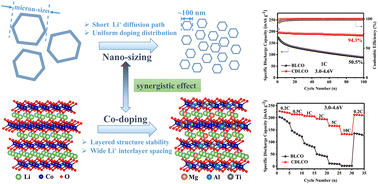Nanoscale control and tri-element co-doping of 4.6 V LiCoO2 with excellent rate capability and long-cycling stability for lithium-ion batteries†
Abstract
Structural instability at high voltage severely restricts the reversible capacity of the LiCoO2 cathode. Moreover, the main difficulties in achieving high-rate performance of LiCoO2 are the long Li+ diffusion distance and slow Li+ intercalation/extraction during the cycle. Thus, we designed a modification strategy of nanosizing and tri-element co-doping to synergistically enhance the electrochemical performance of LiCoO2 at high voltage (4.6 V). Mg, Al, and Ti co-doping maintains the structural stability and phase transition reversibility, which promotes the cycling performance of LiCoO2. After 100 cycles at 1 C, the capacity retention of the modified LiCoO2 reached 94.3%. In addition, the tri-elemental co-doping increases Li+ interlayer spacing and enhances Li+ diffusivity by tens of times. Simultaneously, nanosize modification decreases Li+ diffusion distance, leading to a significantly enhanced rate capacity of 132 mA h g−1 at 10 C, much better than that of the unmodified LiCoO2 (2 mA h g−1). After 600 cycles at 5 C, the specific capacity remains at 135 mA h g−1 with a capacity retention of 91%. The nanosizing co-doping strategy synchronously enhanced the rate capability and cycling performance of LiCoO2.



 Please wait while we load your content...
Please wait while we load your content...